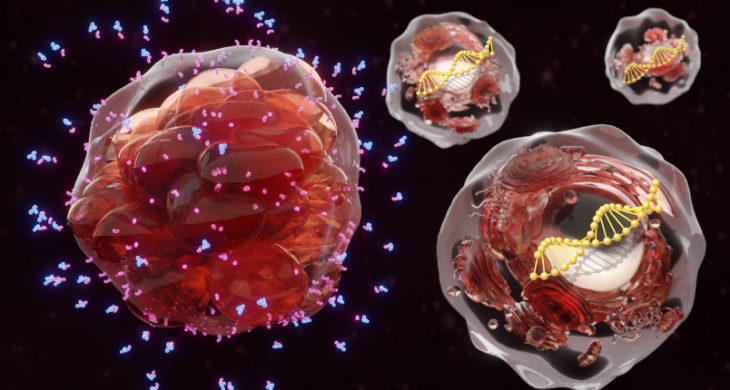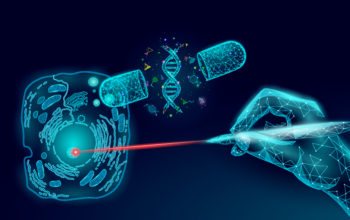
Date: 11th February 2022
The immune system is a critical biological network of processes that protects an organism from disease, and depends on the ability to distinguish self from non-self, a role driven by antigens. In humans, T cells respond to antigen stimulation together with the production of cytokines however, dysregulation can occur in autoimmune disease, immunodeficiencies, and cancer for example. A systematic understanding of the regulators that orchestrate T cell activation with the ability to activate and inhibit gene function would offer valuable insights into disease pathways. Using gain- and loss-of-function CRISPR screens to systematically perturb genes would be highly advantageous but deploying them at scale in primary cell types has to date been challenging. Now, researchers have developed a CRISPR activation (CRISPRa) and CRISPR interference (CRISPRi) discovery platform in primary human T cells and performed genome-wide screens for functional regulators of cytokine production in response to stimulation.
CRISPR technology has rapidly advanced over the last decade and is no longer used exclusively to ‘cut’ DNA. CRISPRa and CRISPRi screens are powerful tools for gain-of-function and loss-of-function studies and utlilise nuclease-defective Cas9 (dCas9) fused to a transcription activator or repressor domain. In contrast to a CRISPR knockout, CRISPRa and CRISPRi require the sustained expression of the Cas protein, however this has been hindered in human primary cells at large-scale due to poor and inefficient lentiviral delivery systems.
Now, reasearchers at Gladstone Institutes and UC San Francisco (UCSF), US, led by Alexander Marson, have developed an optimised method of lentiviral delivery creating a CRISPRa and CRISPRi screening platform for use in primary human T cells. This allowed for the systematic discovery of genes and pathways that can be perturbed to tune stimulation-dependent cytokine responses.
The team started using pools of CRISPRa/i-perturbed human T cells isolated from healthy volunteers. They activated or inactivated nearly 20,000 genes and sorted the cells into high and low groups based on levels of endogenous Interleukin-2 (IL-2) production in CD4+ T cells or interferon-γ (IFN-γ) production in CD8+ T cells. They screened the resulting cells for changes to cytokine production and homed in on hundreds of genes that serve as key cytokine regulators, including some never before identified in knock-out screens.
Gene-level statistical analysis of the IL-2 and IFN-γ CRISPRa screens revealed 444 and 471 hits, respectively, including 171 shared hits. The reciprocal screen using CRISPRi identified 226 and 203 gene hits, respectively, including 92 shared hits.
The CRISPRa screen was effective in identifying limiting factors in cytokine production but this method could miss necessary components that would only be identified through loss-of-function studies. As expected, the CRISPRi hits were biased toward genes with high mRNA expression.
Together, the CRISPRi and CRISPRa platform revealed hits in both core and context-specific regulators of cytokine production. Each screen identified regulatory components missed by the other screen, highlighting the complementary nature of the dual CRISPRa and CRISPRi approach for the comprehensive discovery of functional cytokine regulators.
The team also developed a platform for pooled CRISPRa perturbations coupled with single-cell RNA-sequencing (scRNA-seq) readout (CRISPRa Perturb-seq) and used it for deep molecular characterisation of single-cell states targeting 70 hits and controls from their genome-wide CRISPRa cytokine screens. This revealed how regulators of cytokine production both tune T cell activation and program cells into different stimulation-responsive states.
Conclusions and future applications
The team here demonstrated for the first time successful use of complimentary CRISPRa and CRISPRi optimised for high efficiencies at a large scale in primary human cells. Paired CRISPRa and CRISPRi screens were able to decode the genetic programs regulating stimulation-responsive cytokine production in primary human T cells. CRISPRi identified required cytokine regulators, whereas CRISPRa uncovered key signaling bottlenecks in pathway function as well as regulators that are not necessarily active in ex vivo–cultured T cells.
In the immediate future the Marson lab will hone in on individual genes identified in the screen to unravel their role in cytokine regulations. They will also use the dual approach to discover genes that control other critical traits in human immune cells.
This new data has provided the team with a T cell instruction manual, which they plan to further expand. They are hoping by understanding how to program T cells they can improve and boost the ability of T cells to fight diseases such as cancer by for example altering their cytokine production. This could in theory translate to making CAR-T cell therapy more effective and powerful.
CRISPRa is a relative new comer in the gene manipulation arsenal however, it is rapidly gaining traction in the fight against disease. Scientists have exploited CRISPRa to directly augment expression of endogenous genes encoding tumour-associated antigens, leading to a more pronounced antitumor immune response in mice. The wealth of data generated here by the CRISPRa/i screening platform would feedback nicely into such experiments. CRISPRa has also been used in vivo to decrease seizures and rescue cognitive deficits in a rodent model of epilepsy, by increasing endogenous gene expression which decreases neuron excitability. Scientists have even discovered a way to fine tune CRISPR activation – developing a dose-dependent and reversible CRISPRa system. These advances, now together with a new instruction manual for T cells should drive synthetic gene programs that can be CRISPR-engineered into the next generation of immunotherapies with the aim of treating a broad-range of diseases.
For more information please see the press release at Gladstone Institutes
Schmidt, R., Steinhart, Z., Layeghi, M., Freimer, J.W., Bueno, R., Nguyen, V.Q., Blaeschke, F., Ye, C.J., and Marson, A. (2022). CRISPR activation and interference screens decode stimulation responses in primary human T cells. Science 375, eabj4008.
https://doi.org/10.1126/science.abj4008
http://eha.3a7.mywebsitetransfer.com/crispr-activation-as-a-tool-to-reveal-hiding-cancer-cells/
http://eha.3a7.mywebsitetransfer.com/in-vivo-crispra-alleviates-epilepsy/
http://eha.3a7.mywebsitetransfer.com/dose-dependent-crispr-activation/
